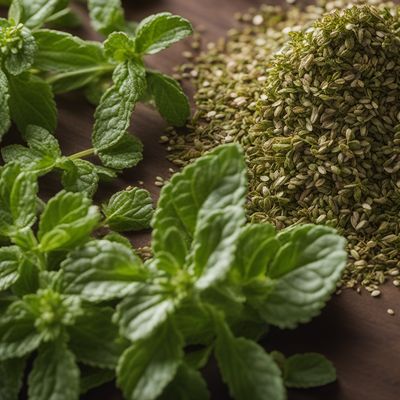
Ingredient
Cretan oregano
The Fragrant Herb of the Mediterranean
Cretan oregano is a perennial herb with small, oval-shaped leaves that are gray-green in color. It has a strong, pungent aroma and a slightly bitter taste. The herb adds depth and complexity to dishes, making it a staple in Greek, Italian, and Middle Eastern cuisines. Its dried form is commonly used in spice blends, marinades, and sauces.
Origins and history
Cretan oregano has been cultivated in the Mediterranean region for centuries and is particularly associated with Greek cuisine. It has a rich history dating back to ancient times, where it was used for medicinal purposes and as a symbol of joy and happiness. Today, it is still widely grown in the Mediterranean and is an essential ingredient in traditional dishes like Greek moussaka and Italian pizza.
Nutritional information
Cretan oregano is a good source of antioxidants, vitamins A and K, and minerals such as calcium and iron. It also contains essential oils that have antimicrobial and anti-inflammatory properties.
Allergens
There are no known allergens associated with Cretan oregano.
How to select
When selecting Cretan oregano, look for dried leaves that are vibrant in color and have a strong, fragrant aroma. Avoid any packages that appear dull or have a weak scent, as they may be stale or of lower quality. Fresh oregano should have firm leaves and a vibrant green color.
Storage recommendations
To maintain the freshness of Cretan oregano, store dried leaves in an airtight container in a cool, dark place. Fresh oregano can be stored in the refrigerator, wrapped in a damp paper towel and placed in a plastic bag. It is best used within a week of purchase for optimal flavor.
How to produce
Cretan oregano can be easily grown in a sunny spot in your garden or in a pot on your balcony. It thrives in well-drained soil and requires minimal maintenance. Regular pruning will help promote bushier growth and ensure a continuous supply of fresh leaves.
Preparation tips
Cretan oregano can be used in a variety of dishes, including soups, stews, roasted meats, and grilled vegetables. It pairs well with tomatoes, olives, garlic, and lemon. Add it towards the end of cooking to preserve its flavor. It can also be used to infuse oils and vinegars for added depth of flavor.
Substitutions
Thyme and marjoram can be used as substitutes for Cretan oregano, although they have slightly different flavor profiles. Use them in the same quantity as the recipe calls for, adjusting to taste if necessary.
Culinary uses
Cretan oregano is commonly used in Mediterranean cuisine, particularly in Greek, Italian, and Middle Eastern dishes. It is a key ingredient in Greek salads, pasta sauces, and roasted lamb. It adds a distinct flavor to marinades, dressings, and herb rubs for grilled meats and vegetables.
Availability
Cretan oregano is commonly available in the Mediterranean region, particularly in Greece and Italy. It can also be found in specialty stores and online retailers worldwide.
More ingredients from this category

Lemon savory
The Zesty Herb: Lemon Savory and its Citrusy Twist

Mastic thyme
The Fragrant Herb: Unveiling the Aromatic Delights of Mastic Thyme

Oregano
The Herb of Mediterranean Delights

Winter savory
Savoring the Season: Exploring the Delights of Winter Savory

Summer savory
"The Herb of Warmth and Flavor"

Lemon thyme
The Zesty Herb

Syrian oregano
The Exotic Herb: Syrian Oregano

Creeping thyme
The Fragrant Delight of Creeping Thyme

Thyme
The Fragrant Herb: Thyme

Marjoram
The Fragrant Herb: Marjoram
Recipes using Cretan oregano

Cretan Poffert - A Delicious Twist on a Dutch Classic
Mediterranean Delight: Cretan Poffert - A Fusion of Dutch and Cretan Flavors

Cretan Honey Meringue Cookies
Honeyed Clouds: Cretan Meringue Cookies

Cretan-style Lentil Stew
Mediterranean Lentil Delight

Cretan Cinnamon Biscotti
Cretan Delight: Cinnamon Biscotti with a Mediterranean Twist

Cretan Trapizzino
Mediterranean Delight: Cretan Twist on the Italian Trapizzino

Cretan Kiwi Soufflé
Zesty Kiwi Delight: A Cretan Twist on Soufflé